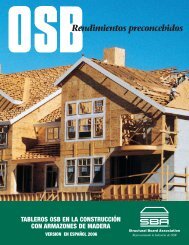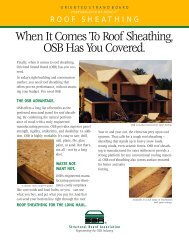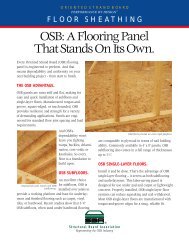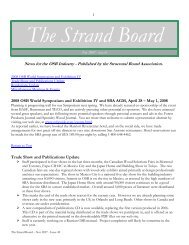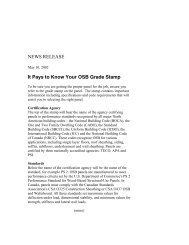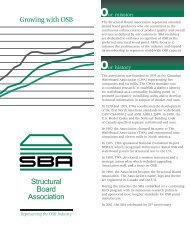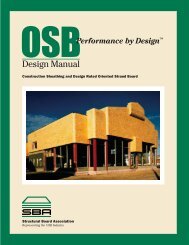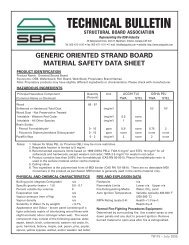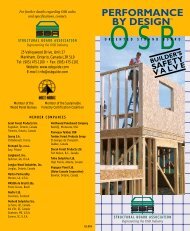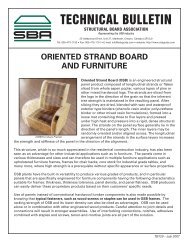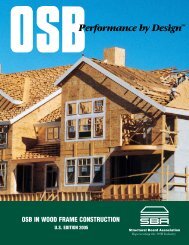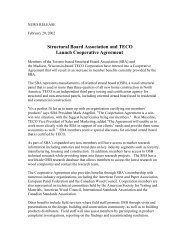OSB And The Humid Environment - OSBGuide - TECO
OSB And The Humid Environment - OSBGuide - TECO
OSB And The Humid Environment - OSBGuide - TECO
Create successful ePaper yourself
Turn your PDF publications into a flip-book with our unique Google optimized e-Paper software.
ORIENTED STRAND BOARD<br />
PERFORMANCE BY DESIGN TM<br />
TECHNICAL BULLETIN<br />
<strong>OSB</strong> <strong>And</strong> <strong>The</strong><br />
<strong>Humid</strong> <strong>Environment</strong><br />
PRODUCT OVERVIEW<br />
Oriented Strand Board (<strong>OSB</strong>) is an engineered structual<br />
wood panel. <strong>OSB</strong> is made by processing small diameter,<br />
fast growing trees into thin strands which are bonded<br />
together under heat and presure with an exterior resin<br />
binder. <strong>OSB</strong> is manufactured to a performance standard<br />
which identifies the structural and physical performance,<br />
fastener holding and adhesive bond durability<br />
requirements needed for a particular end-use, or<br />
alternatively but less frequently to a product standard<br />
which specifies the minimum mechanical and physical<br />
properties for the grade.<br />
WOOD & MOISTURE<br />
All wood products naturally contain water. In fact, the<br />
natural moisture content in solid wood can vary from 25<br />
percent to more than 200 percent. In the manufacturing<br />
process, most of that natural moisture content is removed.<br />
With <strong>OSB</strong>, wood strands cut from green wood are typically<br />
dried to between three to eight percent moisture content.<br />
<strong>The</strong> wood strands are then coated with powdered or liquid<br />
resins and a small amount of wax. <strong>The</strong>se resin binders<br />
together with the wax will contribute to <strong>OSB</strong>’s moisture<br />
resistant qualities. However, like alll wood products, <strong>OSB</strong><br />
will react to change in moisture and humidity in service.<br />
EXTERIOR-TYPE RESIN BINDERS<br />
resin binders used for construction products are generally<br />
of two types, Exterior for use under conditions exposed<br />
to humid weather or high humidity and Interior for use<br />
under dry humidity levels.Exterior type resin binders are<br />
cured during the high tempperature pressing process<br />
which brings the binder components together to form a<br />
very stable, insoluble, waterproof and boilproof<br />
connection between the <strong>OSB</strong> strands making up the<br />
panel. Interior type resin binders are slowly soluble in<br />
water and are primarily for interioruse such as wall<br />
paneling, cabinets and furniture.<br />
BOND CLASSIFICATION<br />
All trademark stamps must state the panel’s Bond<br />
Classification. This classification is a designationof the<br />
moisture resistance of the glue bond and is related to the<br />
intended end use. It is a function of the structural panel’s<br />
raw material composition and its adhesive bond<br />
durability. <strong>OSB</strong> panels intended for construction are<br />
marked Expoure 1, in accordance with the US-DOC<br />
Voluntary Product Standard PS2, or Exterior Type Bond<br />
in accordance with Canadian Building Codes.<br />
EXPOSURE 1<br />
the Exposure 1 Bond Classification indicates continued<br />
performance where delays in construction may cause the<br />
panels to be exposed to the weather before being<br />
protected. Like CDX plywood, <strong>OSB</strong> panels with this<br />
designation are intended for protcted construction uses<br />
not permanently exposed to the weather, intended to<br />
resist moisture exposure due to construction delays, or<br />
other conditions of similsr severity. <strong>OSB</strong> panels marked<br />
Expoure 1 must meet specific (i.e. moisture cycling) bond<br />
requirements.<br />
®<br />
Structural Board Association<br />
Representing the <strong>OSB</strong> Industry
PANEL CERTIFICATION<br />
<strong>OSB</strong> panels intended for construction will bear<br />
the stamp of an accredited third party testing and<br />
inspection agency. Principle agencies include APA –<br />
<strong>The</strong> Engineered Wood Association, <strong>TECO</strong> Corp. and<br />
PSI/PTL Inc. <strong>The</strong> trade mark includes nominal<br />
thickness, span rating, bond classification, the symbol<br />
PS2, the name or logo of the testing agency and the<br />
manufacturer’s name.<br />
MOISTURE PROTECTION<br />
<strong>OSB</strong> panels are edge-coated with a proprietary water<br />
resistant sealer to reduce edge swelling. If needed,<br />
panels should be cut to preserve as much of the edge<br />
coating as possible. Remaining panel edges that may be<br />
exposed to moisture should either be protected or<br />
coated with an exterior latex paint. When panels are to<br />
be exposed to the weather such as the exterior walls of<br />
carports, garden sheds, or fascia boards, they should be<br />
painted or stained. Panels intended for painting should<br />
be primed with a good quality primer; panels that will<br />
be stained, should be treated with a water-repellent<br />
primer compatible with the stain finish.<br />
VAPOR BARRIERS FOR FLOORING<br />
Although <strong>OSB</strong> floor sheathing panels have low moisture<br />
permeability, local building codes may require the use<br />
of a vapor barrier on the underside of the panel. If so,<br />
consult with the local building inspector or hardwood<br />
flooring manufacturer as to the type and method of<br />
installation.<br />
SHIPPING, HANDLING & STORING<br />
Reasonable care is required in warehousing and storage<br />
of <strong>OSB</strong>, especially on the job site, to protect panels from<br />
mechanical damage and lengthy exposure to adverse<br />
moisture conditions. For best results, handle panels as<br />
little as possible. Ship and store in the original units, if<br />
possible. Use care in handling the panels to avoid<br />
damaging corners and edges. Store <strong>OSB</strong> panels produced<br />
by SBA mills indoors or under cover with enough<br />
support so that panels remain flat. Provide air<br />
circulation around panels by keeping covers open and<br />
away from sides and bottoms of units. Make sure to<br />
elevate panels above ground and standing water.<br />
JOBSITE CARE OF <strong>OSB</strong><br />
With all wood products, care should be taken to avoid<br />
contact with free moisture. Because this is not always<br />
possible, especially in the early stages of construction,<br />
the Structural Board Association recommends the<br />
following precautions to minimize the effects of<br />
moisture on <strong>OSB</strong>:<br />
• If heavy rainfall or melting snow comes in contact<br />
with <strong>OSB</strong> floors, it is recommended that all<br />
moisture be removed by shoveling, sweeping, etc.<br />
• If ponding occurs, holes should be drilled in the<br />
affected areas to drain the water.<br />
• If <strong>OSB</strong> floors are exposed to prolonged moisture<br />
during construction, it may be necessary to sand<br />
the edges and surface slightly to remove any high<br />
spots.<br />
• Prior to installation of the floor covering the <strong>OSB</strong><br />
subfloor should be dry and thoroughly swept or<br />
vacuumed to remove any dirt or debris remaining<br />
from the construction.<br />
When using <strong>OSB</strong> as roof sheathing, it is recommended<br />
that the roofing materials – felt, shingles, shakes, etc. –<br />
be installed as soon as possible after completing the<br />
sheathing installation. For larger flat roofs, built-up a<br />
roofing materials should be placed in sequence as the<br />
sheathing installation progresses.<br />
When using <strong>OSB</strong> as wall sheathing, under siding or<br />
stucco, protect the panels by installing good quality<br />
sheathing paper or sheathing membrane over the panels<br />
prior to placing the siding or stucco. Pay particular<br />
attention to wrapping the sheathing membrane around<br />
the edges of all openings.<br />
REMINDER<br />
Please remember to gap <strong>OSB</strong> panels when used as roof,<br />
wall and floor sheathing. <strong>The</strong>se recommended gaps of<br />
1<br />
⁄8" must also be left around all openings. Also keep <strong>OSB</strong><br />
panels a minimum of eight inches above grade when<br />
installed as wall sheathing.<br />
25 Valleywood Drive, Unit 27, Markham, Ontario, Canada L3R 5L9<br />
Tel: (905) 475-1100 • Fax: (905) 475-1101<br />
Web: http://www.osbguide.com Email: info@osbguide.com<br />
Member of the<br />
Wood Panel Bureau<br />
Member of the Sustainable<br />
Forestry Certification Coalition<br />
Printed in Canada<br />
EL812



